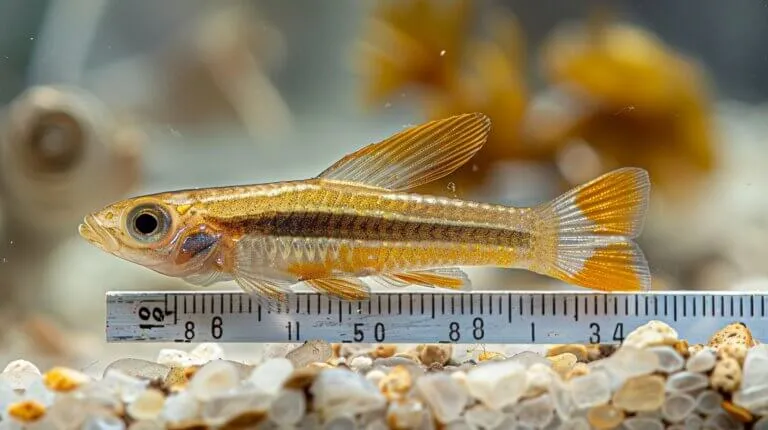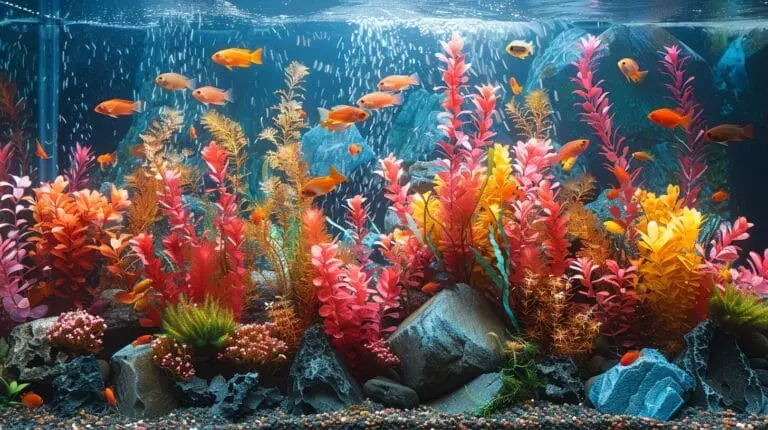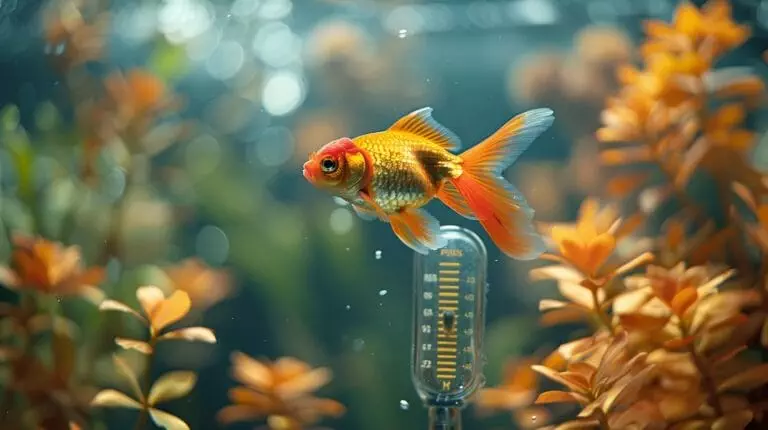Fish staying at the top of your tank can signal trouble. You might wonder, “Why are my fish staying at the top of the tank?” Low oxygen levels, high temperatures, or poor water quality often cause this behavior. 1 As an experienced aquarist, I’ve seen these issues many times. My years of fishkeeping have taught me how to spot and fix these problems quickly.
This guide will help you keep your fish healthy and happy. You’ll learn to check oxygen levels, adjust temperatures, and maintain clean water. We’ll cover common diseases and stress signs too.
By the end, you’ll know exactly what to do when your fish swim up top. Are you ready to start?
Key Takeaways
- Fish at the top of the tank often means low oxygen or poor water quality.
- Add air pumps, do water changes, and clean filters to fix oxygen problems.
- Test water weekly for ammonia, nitrates, and pH to keep fish healthy.
- Some fish naturally swim at the top, but gasping or staying there too long is bad.
- Live plants, proper diet, and adequate hiding spots help reduce fish stress in tanks.
Understanding Oxygen Levels and Fish Behavior in Aquariums

Fish need oxygen to live. When there’s not enough, they swim to the surface of the tank where oxygen is highest.
The Critical Role of Oxygen in Fish Tank Health
Oxygen is vital for your fish. It keeps them alive and active. Your aquarium needs 6 to 8 mg/L of dissolved oxygen for healthy fish. Low levels can make fish gasp at the surface. 1 They may also swim sluggishly or stop eating.
To boost enough oxygen, add an air pump or air stone to your tank. These create bubbles that mix air into the water. 2
Water temperature affects oxygen levels too. Warmer water holds less oxygen. Keep your tank cool, around 75-80°F for most tropical fish. Good water flow helps spread oxygen. Use a filter or powerhead to move water around.
Live aquarium plants also add oxygen during the day. They’re great for your tank’s health and look nice too.
A well-oxygenated tank is the foundation of a thriving aquatic ecosystem.
Identifying Signs of Oxygen Depletion
Fish gasping at the surface means there’s not enough oxygen. You’ll see them hanging near the top, gulping air. Their gills may move fast as they try to get more oxygen. Slow, sluggish movement is another red flag.
Your fish might seem tired or lazy, staying in one spot. Some may even lay on the bottom, barely moving. 3
Watch for these signs closely. Low oxygen can quickly become deadly. Fish start to suffer when levels drop below 4 ppm. At 2 ppm or less, they can suffocate. Quick action is key to save your aquatic friends.
Next, let’s look at how to boost oxygen in your tank.
Enhancing Aeration and Oxygenation in Your Aquarium
Now that you can spot oxygen issues, let’s boost your tank’s air supply. Proper aeration keeps your fish happy and healthy. Here’s how to enhance oxygen levels in your aquarium:
- Increase water movement: Add a powerhead or adjust your filter output to create more surface agitation. This breaks the water’s surface, allowing more oxygen to enter.
- Use air stones: Place these small, porous stones in your tank. They create tiny bubbles that rise, increasing oxygen as they pop at the surface.
- Install a spray bar: Attach this to your filter output. It spreads water across the surface, boosting oxygen exchange. 2
- Add live plants: Aquatic plants produce oxygen during the day. Choose easy-to-grow options like Java Fern or Anubias.
- Perform water changes: Replace 10-25% of your tank water weekly. New water has more dissolved oxygen.
- Lower water temperature: Cooler water holds more oxygen. Keep your tank at the lower end of your fish’s ideal range. 4
- Reduce fish load: Fewer fish means less oxygen demand. Stick to the “one inch of fish per gallon” rule.
- Clean your filter: A clogged filter can’t move water effectively. Rinse media in old tank water monthly.
- Use a Hang-On-Back (HOB) filter: These create a waterfall effect, increasing surface agitation and oxygen levels.
- Pour water from a height: When doing water changes, pour new water from above. This creates bubbles and increases oxygenation. 2
Diagnosing Poor Water Quality as a Reason for Top-Tank Behavior

Another reason is poor water quality. This can drive fish to the tank’s surface. High ammonia or nitrate levels make fish gasp for air at the top.
The Impact of Ammonia and Nitrate Levels on Fish Comfort
Ammonia and nitrates in your tank can make your fish very sick. High levels force fish to swim up top, gasping for air. These chemicals hurt fish gills and make it hard to breathe. Your fish may show red gills, cloudy eyes, or odd swimming if levels are too high. 5
Testing water often helps catch problems early. Use a good test kit to check ammonia and nitrates weekly. Keep ammonia levels at zero and under 20 ppm for nitrates. Clean filters, do water changes, and don’t overfeed to control these harmful chemicals.
Next, let’s look at how to monitor and fix water quality issues in your tank.
Regular Monitoring and Maintenance to Prevent Water Quality Issues
Regular water checks keep your fish healthy. Test your tank often to catch problems early. 1
- Test weekly: Use a kit to check pH, ammonia, nitrite, and nitrate levels.
- Change water: Replace 10-25% of tank water every 1-2 weeks.
- Clean filter: Rinse filter media in old tank water monthly.
- Vacuum gravel: Remove waste and uneaten food during water changes.
- Check temperature: Keep it steady with a reliable thermometer.
- Observe fish: Look for odd behavior or signs of stress daily.
- Feed right: Give only what fish can eat in 2-3 minutes.
- Manage light: Control algae growth with 8-10 hours of light per day.
- Add plants: Live plants help absorb excess nutrients.
- Keep records: Note test results and changes to spot trends.
Understanding the Link Between Overcrowding and Water Quality
Too many fish in your tank can harm water quality fast. Each fish adds waste to the water. This waste turns into ammonia and nitrates. These chemicals can hurt or kill your fish if levels get too high.
Overcrowding also uses up oxygen quickly. Fish may gasp at the surface when oxygen is low. To keep your fish healthy, follow the “one inch of fish per gallon” rule. 6 Test your water often and do regular water changes to control nitrate levels.
Recognizing Disease and Distress in Aquarium Fish

Fish can show signs of illness through odd swimming patterns or staying at the tank’s top. Learn more about spotting these signs to keep your aquatic pets healthy.
Common Illnesses That Cause Fish to Swim to the Top
Swim bladder disease often causes fish to float at the top. This illness affects a fish’s buoyancy control. Infected fish struggle to swim normally and may flip upside down. Other common top-swimming illnesses include gill diseases and parasites.
These issues make it hard for fish to breathe, forcing them to seek oxygen at the surface. 7High nitrate levels in the tank can also push fish upward. This problem stems from poor water quality.
Regular water changes help fix this issue. Clean filters and remove uneaten food to keep nitrates low. Your fish will thank you by swimming happily throughout the tank. 8
Behavioral Signs of Stress and Ailment in Aquarium Fish
Moving from common illnesses, let’s explore how fish show stress and sickness. Fish can’t talk, but they speak through actions. Your fish may change color, breathe fast, or hide more. These are key signs of trouble. 9
Stressed fish often lose their appetite. They might gasp at the water’s surface due to low oxygen. Some fish rub against objects or swim oddly. Watch for white spots or fuzzy patches on their bodies.
These signs mean your fish need help fast. Keep an eye out and act quick to save your finned friends. 10
Creating a Safe and Stress-Free Aquarium Environment
A stress-free aquarium keeps fish happy and healthy. You can create a safe environment with these steps:
- Add hiding spots: Use plants, rocks, and decorations to give fish places to rest and feel secure.
- Control light: Dim lights at night to mimic natural cycles and reduce stress.
- Maintain water quality: Test pH, ammonia, and nitrate levels weekly. Change 10% to 25% of water every 1 to 2 weeks. 1
- Ensure proper aeration: Use air pumps or bubblers if fish gasp at the surface. 9
- Feed a balanced diet: Offer varied foods like flakes, pellets, and frozen treats to meet nutritional needs.
- Avoid overcrowding: Follow the one-inch of fish per gallon rule to give fish ample space.
- Keep compatible species: Research fish types to prevent aggression and stress from mismatched tank mates.
- Maintain stable temperatures: Use a heater to keep water at the right level for your fish species.
- Reduce noise and vibrations: Place the tank away from TVs, speakers, and high-traffic areas.
- Perform regular health checks: Look for signs of disease or stress daily, such as odd swimming or loss of appetite.
Next, we’ll explore how to identify normal vs. alarming fish swimming behaviors.
Identifying Normal vs. Alarming Fish Swimming Behaviors

Fish behavior can tell you a lot about their health. Some fish naturally swim near the top, while others only do it when something’s wrong.
Distinguishing Normal Top-Tank Behavior in Certain Fish Species
Some fish species naturally hang out near the top of the tank. Surface-dwelling fish like hatchetfish and mollies often swim close to the water’s edge. These fish have special adaptations for life at the surface.
They may feed on insects or plants that float on top. Their normal behavior includes active swimming and searching for food at the surface. 8
You can spot healthy top-dwelling fish by their lively movements. They should swim smoothly and show interest in their surroundings. Gasping or struggling at the surface isn’t normal for any fish.
If you see this, check your water quality right away. Healthy surface fish will dive deeper when startled, then return to the top. Keep an eye on your fish’s usual habits to notice any changes quickly.
When to Worry About Persistent Surface Swimming
Fish at the tank’s top for long periods can signal trouble. You should worry if this lasts more than a day. Look for other signs like rapid gill movement or gasping. These point to low oxygen levels or poor water quality.
Sick fish may also hang near the surface. Check for white spots, fungus, or clamped fins. These symptoms need quick action. 8
High water temps can cause surface swimming too. Warm water holds less oxygen. Use a thermometer to check if your tank is too hot. Aim for the right temp for your fish type. If you see many fish at the top, test your water right away.
High ammonia or nitrate levels force fish upward. Regular water changes and proper filtration help prevent these issues.
Poor nutrition can lead to unusual behavior in your fish, including staying at the top of the tank. When fish are not receiving the right balance of nutrients… 1
Observation and Record-Keeping for Behavioral Changes
After spotting persistent surface swimming, it’s crucial to track your fish’s behavior. Keep a daily log of your aquarium. Note when fish surface for air. 8 This can signal low oxygen levels.
Jot down water conditions too. Include ammonia and oxygen readings. These records help spot patterns and changes over time.
Your notes become a valuable tool for fish health. They reveal subtle shifts you might miss day-to-day. Use a simple chart or app to log data. This makes it easy to spot trends. 11 Regular records also help if you need to consult a fish expert. With clear data, they can give better advice on fixing tank issues.
Implementing Solutions for Top-Tank Behavior in Fish

Ready to fix your fish’s top-tank behavior? Let’s explore some easy solutions. We’ll look at simple changes you can make to your tank setup and fish care routine.
Adjusting Tank Conditions to Encourage Healthy Swimming Patterns
Healthy fish swim all over the tank. To keep your fish happy, you need to adjust their home. Here’s how to create the best tank conditions:
- Check water temperature daily. Keep it stable between 75°F to 80°F for most tropical fish.
- Test water quality weekly. Aim for zero ammonia, low nitrates, and a pH of 6.8 to 7.2.
- Add an air pump or bubbler. This boosts oxygen levels in the water.
- Clean the filter monthly. A clean filter removes waste and keeps water clear.
- Do 25% water changes every week. Fresh water helps remove toxins.
- Avoid overfeeding. Give fish only what they can eat in 2 minutes, twice a day.
- Add live plants. They produce oxygen and absorb nitrates.
- Create hiding spots with rocks or aquarium decorations. This reduces stress for shy fish.
- Use a timer for tank lights. 8 to 10 hours of light daily mimics natural cycles.
- Treat tap water with a dechlorinator before adding it to the tank.
Next, let’s look at how diet affects fish behavior in the tank.
The Role of Diet and Feeding in Fish Placement within the Tank
Fish food plays a big role in where your fish swim. Feeding your fish at the top of the tank can make them stay there more. This happens because they learn to expect food from that spot.
Try feeding your fish in different areas of the tank. Use sinking pellets or wafers to encourage bottom-dwelling. For mid-level feeders, drop food in the middle of the tank.
Your fish’s diet affects their health and behavior too. Give them a mix of foods to meet all their needs. This includes flakes, pellets, frozen or live foods. Each type of food floats or sinks differently in the tank.
This variety helps fish use all parts of their home. A good diet also keeps fish strong and less likely to get sick. 1
The Benefits of Aquatic Plants and Natural Decorations
Proper diet and feeding habits set the stage for a healthy tank. Now, let’s explore how plants and decorations can boost your aquarium’s appeal and function.
- Oxygen boost: Live aquatic plants produce oxygen through photosynthesis. This extra O2 helps fish breathe easier and stay active. 1
- Natural filters: Plants absorb harmful chemicals like ammonia and nitrates. They act as living filters, keeping water cleaner for longer.
- Stress reduction: Natural decor gives fish places to hide and explore. This mimics their wild habitats and lowers stress levels.
- Algae control: Plants compete with algae for nutrients. Fewer nutrients mean less algae growth in your tank.
- pH balance: Some plants help maintain a stable pH level. This creates a more stable environment for your fish.
- Visual appeal: Live plants and natural decor make tanks look more vibrant. They create a slice of nature in your home.
- Breeding grounds: Many fish lay eggs on plant leaves. Natural decor provides safe spots for fish to breed and raise young.
- Food source: Some fish nibble on plant matter. Live plants offer a healthy snack option for herbivorous species.
- Temperature control: Plants can help regulate water temperature. They provide shade and reduce heat from lights.
Conclusion
Fish at the tank’s top often signal trouble. You must act fast to save them. Check oxygen levels, water quality, and tank conditions. Add air stones or adjust filters to boost oxygen.
Clean the tank and change water regularly. Your quick action can keep your fish healthy and happy. Watch them closely and enjoy your thriving aquarium.
FAQs
1. Why are my fish staying at the top of the tank?
Fish may stay up top due to low oxygen, high ammonia, or swim bladder issues. Check water quality and look for signs of illness.
2. How can I fix low oxygen in my tank?
Add an air pump or air stone to boost oxygen. Make sure your filter works well. Don’t overcrowd the tank with too many fish.
3. What are signs of ammonia problems?
Fish gasping at the surface, red gills, and loss of appetite can mean high ammonia. Test water often and do partial changes to keep levels safe.
4. Could my fish have swim bladder disease?
Yes. If fish float oddly or struggle to swim down, it might be swim bladder trouble. Try fasting them for a day, then feed peas to help.
5. How do I know if my tank is too cold for my fish?
Cold water slows fish down. They may hang at the top where it’s warmer. Use a heater to keep temp steady for your type of fish.
6. When should I quarantine new fish?
Always isolate new fish for 2 to 4 weeks before adding them to your main tank. This stops diseases from spreading to your other fish.
References
- ^ https://www.fao.org/fishery/docs/CDrom/aquaculture/a0844t/docrep/009/T1623E/T1623E03.htm
- ^ https://atlas-scientific.com/blog/how-to-increase-oxygen-in-a-fish-tank/ (2022-02-25)
- ^ https://atlas-scientific.com/blog/how-to-test-oxygen-levels-in-a-fish-tank/ (2024-08-14)
- ^ https://www.tfhmagazine.com/articles/aquarium-basics/aeration-and-oxygenation
- ^ https://www.aquariumpharm.com/fish-gasping-at-the-waters-surface/
- ^ https://injaf.org/articles-guides/general-guides/understanding-fish-stocking-guides/
- ^ https://be.chewy.com/what-is-swim-bladder-disease-and-how-is-it-treated/ (2023-12-21)
- ^ https://kb.rspca.org.au/knowledge-base/why-is-water-quality-important-when-setting-up-a-fish-aquarium/
- ^ https://be.chewy.com/aquarium-fish-stress/
- ^ https://www.co2art.us/blogs/blog/stress-factors-for-aquarium-fish?srsltid=AfmBOoofk-zqFokdxkPeFEHC_PZz98yL85Q2GRMnDR9KCt2-XIEhIxKW
- ^ https://www.aquariumpharm.com/fish-swimming-back-and-forth/






